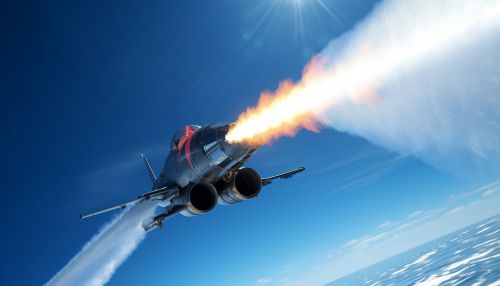Compressible flow
Introduction
Compressible flow, or gas dynamics, is a branch of fluid mechanics that deals with flows where the fluid's density can vary significantly as a result of changes in pressure and temperature. Unlike incompressible flow, where density remains constant, compressible flow accounts for the density changes that occur with variations in pressure and temperature.


Basic Concepts
Compressibility is a measure of the relative volume change of a fluid or solid as a response to a pressure change. In compressible flow, the fluid's density can change, which in turn affects the fluid's velocity and pressure. This is in contrast to incompressible flow, where the density of the fluid remains constant.
Mach Number
The Mach number, named after Austrian physicist Ernst Mach, is a dimensionless quantity representing the speed of flow relative to the speed of sound in the medium. It is a critical parameter in the study of compressible flow, as it determines the flow regime, whether it is subsonic (Mach number less than 1), sonic (Mach number equals 1), or supersonic (Mach number greater than 1).
Speed of Sound
The Speed of sound is the distance travelled per unit time by a sound wave through an elastic medium. In fluids, the speed of sound relates to changes in pressure and density. It plays a crucial role in compressible flow, as it affects the Mach number and the flow regime.
Compressibility Factor
The compressibility factor, or Z-factor, is a dimensionless value that represents the deviation of a real gas from ideal gas behavior. It is used in the state equation of a real gas and is critical in the study of compressible flow.
Governing Equations
The behavior of compressible flow is governed by a set of equations known as the Navier-Stokes equations. These equations, derived from the principles of conservation of mass, momentum, and energy, describe how the velocity, pressure, temperature, and density of a fluid are related.
Conservation of Mass
The conservation of mass, also known as the continuity equation, states that the mass of a system must remain constant over time. In terms of compressible flow, this implies that the product of the fluid density, velocity, and cross-sectional area of the flow must remain constant.
Conservation of Momentum
The conservation of momentum, also known as the momentum equation, is derived from Newton's second law of motion. It states that the rate of change of momentum is equal to the sum of the forces on a fluid particle.
Conservation of Energy
The conservation of energy, also known as the energy equation or the first law of thermodynamics, states that energy cannot be created or destroyed, only transferred or converted from one form to another. In compressible flow, this equation is used to relate the changes in kinetic, potential, and internal energy of a fluid particle.
Flow Regimes
Depending on the Mach number, compressible flows can be classified into different regimes: subsonic, transonic, sonic, supersonic, and hypersonic.
Subsonic Flow
In subsonic flow, the flow velocity is less than the speed of sound. The flow is characterized by smooth streamlines and small changes in pressure and density.
Transonic Flow
Transonic flow occurs when the flow velocity is approximately equal to the speed of sound. It is characterized by a mix of subsonic and supersonic flow regions, leading to complex flow patterns and phenomena such as shock waves.
Sonic Flow
Sonic flow occurs when the flow velocity is exactly equal to the speed of sound. This condition is also known as choking and occurs in situations such as the throat of a converging-diverging nozzle.
Supersonic Flow
In supersonic flow, the flow velocity is greater than the speed of sound. The flow is characterized by the presence of shock waves, which are abrupt changes in pressure and density.
Hypersonic Flow
Hypersonic flow occurs when the flow velocity is much greater than the speed of sound, typically five times the speed of sound or more. It is characterized by high temperatures and high pressure changes, leading to chemical reactions in the flow.
Applications
Compressible flow has a wide range of applications in various fields, including aerospace engineering, mechanical engineering, and chemical engineering. It is essential in the design of high-speed aircraft, rockets, and jet engines. It is also important in the design of pipelines and valves in chemical plants and oil refineries, where changes in fluid pressure and temperature can significantly affect fluid density.
